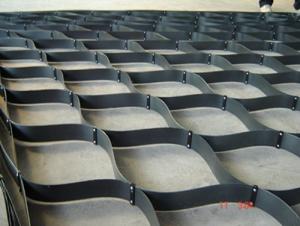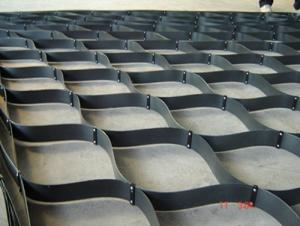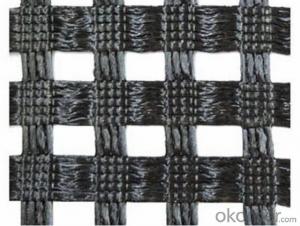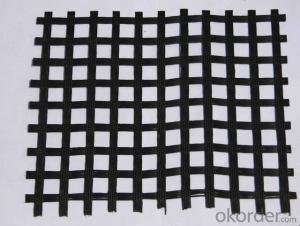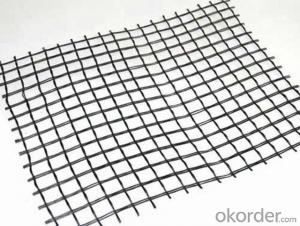HDPE Geocell Smooth Geocell Grass Paver
- Loading Port:
- Tianjin
- Payment Terms:
- TT or LC
- Min Order Qty:
- 1000 m²
- Supply Capability:
- 1900000 m²/month
OKorder Service Pledge
OKorder Financial Service
You Might Also Like
The description of Plastic Geocell for Reforcement treatment for soft soil foundation and steep slope protection highway airport desert mountain and swamp land
Plastic geocell is one new type geosynthetics material, basic sheet is high-molecular polymer, connected by rivets or ultrasonic welded to three-dimensional network structure, unfold it and fill in sand, gravel and clay etc. When used at construction site. According to customer ' s requirement, cut holes or carve arabesquitic in order to increase its lateral permeable ability, also increase the friction and binding force with the foundation material.
Specification of Plastic Geocell for Reforcement treatment for soft soil foundation and steep slope protection highway airport desert mountain and swamp land
TG LG5, TGLG8, TG LGIO, TG LG15, TG LG20 (cm)
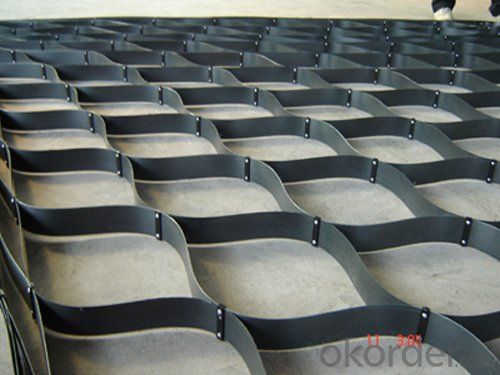
Feature or Property of Plastic Geocell for Reforcement treatment for soft soil foundation and steep slope protection highway airport desert mountain and swamp land
I. Retractile, foldable when transportation, pulled to network when construction, fill in the soil, gravel, concrete etc. Loose materials, form one structure with strong lateral limitations andhigh stiffness
2. Material is light, abrasion resistance, chemical properties stable, resist photooxidation aging, acid and alkali resistant, suitable for different soil and soil conditions, such as desert
3. Good lateral restrict and prevent slippery, prevent deformation, effectively enhance the bearing capacity of subgrade and dispersed loads function
4. The geocell height and welding distance etc. Geometric dimensions are all changeable in order to meet the requirements of different projects
5. Capable and easily be expanded or contracted, small size for transportation, easy for connect and construction speed is fast
Application of Plastic Geocell for Reforcement treatment for soft soil foundation and steep slope protection highway airport desert mountain and swamp land
1. Used for the stability of railway roadbed
2. To stabilize the desert highway roadbed
3. Used in the governance of shallow water channel
4. Used for the foundation reinforcement of retaining wall, wharf, levee
5. For the management of desert, beaches and river banks
Production Standard of Plastic Geocell for Reforcement treatment for soft soil foundation and steep slope protection highway airport desert mountain and swamp land
GB/T19274-2003 <Geosynthetics - Plastic Geocell>
JT/T 516-2004 < Geosynthetics in highway
Engineering - Geocell
Area |
|
Hydraulic | Lagooning and Water Treatment, Ornamental Ponds, Golf Courses Aquaculture and Desalination Water LagoonsTanks, Reservoirs, Liquid WasteFloating Cover SolutionsDrainage and FiltrationShading Cover Solutions |
Environment | Tailing ponds, Leach mining,Landfills,Landfill Capping,Protection against corrosion,Vertical Barriers |
Civil Works | Erosion Control, Secondary Containment, Tunnels,Linear and Surface Works,Consolidation of Margins,Soil Reinforcement,Soil Separation. |
Building | Parkings,Roofing,Soundproofing building |
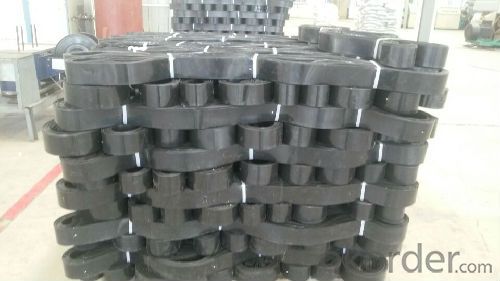
- Q:How do geogrids help in reducing the environmental impact of construction?
- Geogrids help in reducing the environmental impact of construction by providing soil stabilization and reinforcement, reducing the need for excessive excavation and material usage. This results in minimized disturbance to natural habitats, reduced waste generation, and lower carbon emissions, ultimately promoting sustainable construction practices.
- Q:How do geogrids improve the performance of geosynthetic filters?
- Geogrids improve the performance of geosynthetic filters by enhancing their stability and preventing soil erosion. The geogrids provide a reinforcing structure that enhances the filter's tensile strength and prevents the filter from collapsing under heavy loads. This helps to maintain the integrity of the filter and ensures efficient water flow, preventing clogging and maintaining proper drainage. Additionally, geogrids improve the overall durability and longevity of geosynthetic filters, enhancing their effectiveness in various civil engineering and environmental applications.
- Q:How do geogrids improve the performance of mechanically stabilized slopes?
- Geogrids improve the performance of mechanically stabilized slopes by providing reinforcement and stability to the soil. They act as a reinforcement layer within the slope, distributing and transferring loads more effectively. This helps to prevent soil movement and sliding, reducing the risk of slope failure. Geogrids also enhance soil compaction, increase shear strength, and improve overall slope stability, making them an essential component in the construction of mechanically stabilized slopes.
- Q:Can geogrids be used for reinforcement in embankments and dams?
- Yes, geogrids can be used for reinforcement in embankments and dams. Geogrids are a type of geosynthetic material that provide strength and stability to soil structures. They are commonly used in civil engineering projects to reinforce and stabilize embankments and dams, as they improve the overall structural integrity and prevent soil erosion.
- Q:What are the differences between geogrids and geocomposites?
- Geogrids and geocomposites are both used in soil stabilization and reinforcement applications, but they have some key differences. Geogrids are typically made from high-strength polymers or fiberglass, and they have a grid-like structure with open spaces. They are designed to provide tensile strength and distribute loads across a wider area. Geogrids are mainly used for reinforcing soils, retaining walls, and roadways. On the other hand, geocomposites are multi-layered materials that combine different geosynthetic components. They usually consist of a geotextile fabric or membrane bonded to a geogrid or geonet layer. Geocomposites offer a combination of functions such as filtration, drainage, separation, and reinforcement. They are commonly used in applications like erosion control, landfill engineering, and drainage systems. In summary, while geogrids focus on reinforcement and load distribution, geocomposites offer a more versatile solution by combining multiple functions in a single product.
- Q:Can geogrids be used in reinforcement of underground utility corridors?
- Yes, geogrids can be effectively used in the reinforcement of underground utility corridors. Geogrids provide structural support and stability to the soil surrounding the utility corridors, minimizing the risk of settlement and shifting. They improve the load-bearing capacity of the soil, preventing damage and potential collapse of the underground utility infrastructure. Additionally, geogrids can help distribute loads more evenly and reduce stress concentration, ensuring the long-term durability and performance of the utility corridors.
- Q:What are the cost considerations for using geogrids in construction projects?
- Some cost considerations for using geogrids in construction projects include the initial purchase cost of the geogrid material, the installation cost, and the potential long-term cost savings due to increased stability and durability of the construction. Additionally, the cost of maintenance and repairs may be reduced as geogrids can help prevent soil movement and erosion.
- Q:What is the effect of installation damage on geogrid performance in long-term applications?
- The effect of installation damage on geogrid performance in long-term applications can be detrimental. Installation damage, such as punctures, tears, or stretching, can weaken the geogrid's structural integrity and reduce its ability to provide long-term reinforcement. This can lead to decreased stability, reduced load-bearing capacity, and potential failure of the geogrid system over time. Therefore, it is crucial to handle and install geogrids carefully to minimize any damage and ensure optimal performance in long-term applications.
- Q:What is the price of 50kN two-way geogrid
- There are plastic steel, but also more than 4Specializing in the production of geogrid,
- Q:What is the effect of creep on geogrid performance?
- Creep can have a significant impact on the performance of geogrids. Over time, the constant stress and strain on the geogrid can cause it to slowly deform and lose its original shape and strength. This can result in reduced load-bearing capacity and overall effectiveness of the geogrid in reinforcing and stabilizing the soil. It is important to consider creep behavior when designing and selecting geogrids for long-term applications to ensure their durability and performance.
1. Manufacturer Overview |
|
|---|---|
| Location | |
| Year Established | |
| Annual Output Value | |
| Main Markets | |
| Company Certifications | |
2. Manufacturer Certificates |
|
|---|---|
| a) Certification Name | |
| Range | |
| Reference | |
| Validity Period | |
3. Manufacturer Capability |
|
|---|---|
| a)Trade Capacity | |
| Nearest Port | |
| Export Percentage | |
| No.of Employees in Trade Department | |
| Language Spoken: | |
| b)Factory Information | |
| Factory Size: | |
| No. of Production Lines | |
| Contract Manufacturing | |
| Product Price Range | |
Send your message to us
HDPE Geocell Smooth Geocell Grass Paver
- Loading Port:
- Tianjin
- Payment Terms:
- TT or LC
- Min Order Qty:
- 1000 m²
- Supply Capability:
- 1900000 m²/month
OKorder Service Pledge
OKorder Financial Service
Similar products
New products
Hot products
Related keywords
